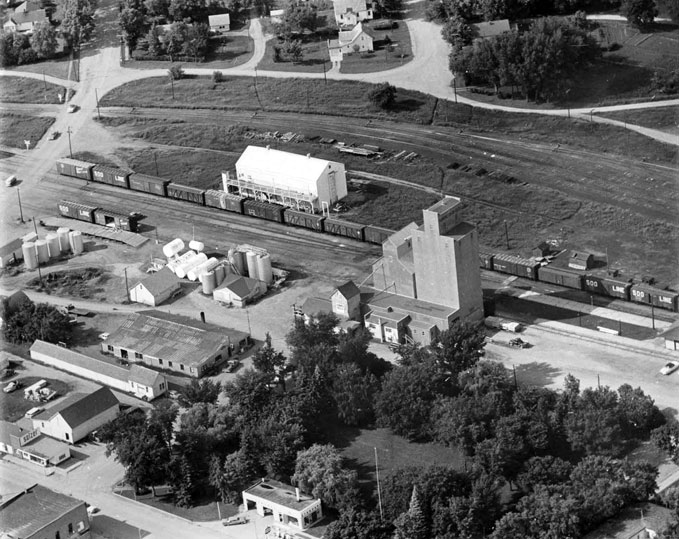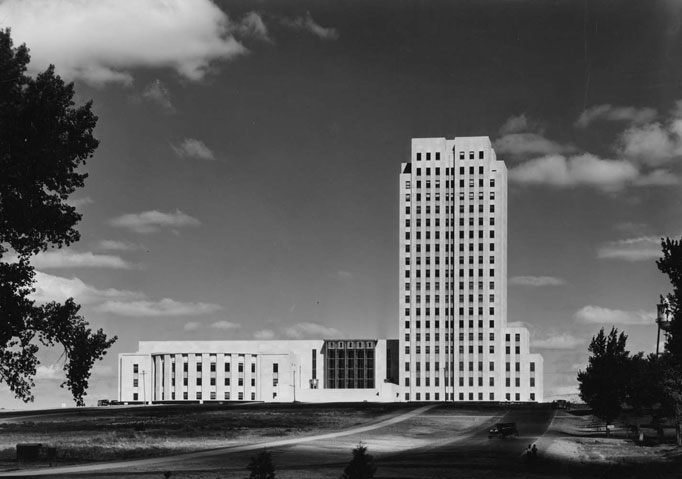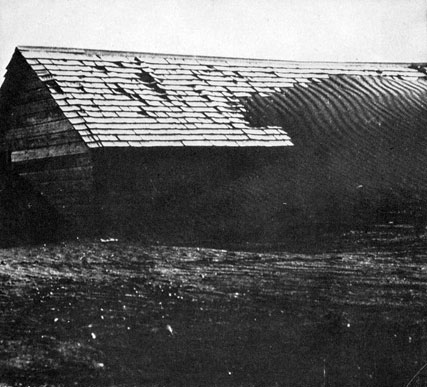The Great Depression of the 1930s both slowed progress and sped change. Heavy farm debt loads and low commodity prices caused a crisis of farm foreclosures and bank failures. Those farmers in a better financial position enlarged their holdings. Rural population diminished while cities grew. North Dakota reached its peak population in 1930, but the total thereafter dropped steadily until 1950.

As a rural state, North Dakota suffered greatly when the prices received for farm produce declined. The search for a solution to that problem brought about different movements in the 1920s and 1930s. For example, cooperatives enjoyed a renewed popularity in the 1920s. As farmers tried to band together to market their produce and reduce the costs of farming, the North Dakota Farmers Union spread across the prairies. Substantial organizing efforts in the mid-1920s resulted in formation of a state Union in 1927; Farmers Union locals built elevators and organized oil cooperatives that served the needs of an increasingly mechanized rural economy. In 1932, the cooperative group helped form a militant defense organization, the Farmers Holiday Organization, to take direct action against low commodity prices and farm foreclosures.
The renewed militancy in rural North Dakota quickly spread into state politics. A revitalized Nonpartisan League emerged in 1932, electing the colorful populist William Langer as Governor. Langer took bold actions when he assumed his office in 1933; he slashed state spending, imposed moratoriums on mortgage foreclosure sales, and embargoed shipment of grain from the state. However, his disregard of law brought Federal investigations, and in 1934 he was convicted of campaign law violations and removed from office; Lt. Governor Ole Olson finished the term. That same year, a divided NPL lost the Governor's office to Democrat Thomas Moodie; he assumed office in 1935, but was quickly disqualified when an investigation discovered that he did not meet state residency requirements. Lt. Governor Walter Welford succeeded Moodie, becoming the fourth Governor in seven months. Langer returned to the electoral wars in 1936 after successfully overturning his conviction and then being exonerated after four new trials in 1935. In 1936, he was re-elected Governor; though defeated in 1938 when he ran for the U.S. Senate, he unseated incumbent Lynn J. Frazier in 1940 and retained that office until his death in 1959.
Though the explosive politics of the 1930s mostly centered on Langer, several other North Dakota leaders received national prominence. Senators Gerald P. Nye and Lynn J. Frazier became known for reflecting the isolationist philosophy prevalent among North Dakota people. Nye's investigation of the role of the munitions industry in bringing the United States into World War I made him a national figure and at the end of the decade he helped lead the national America First movement that sought to keep the nation out of World War II. Frazier established himself as a pacifist by annually proposing a Constitutional amendment to outlaw American participation in foreign wars. In 1936, Congressman William Lemke was nominated for President by the new Union Party; though he received fewer than one million votes, he carried the concerns of drought-stricken farmers throughout the nation.

Despite economic problems, crop failures, dust storms, and weather extremes, North Dakota visibly modernized during the 1930s. The new skyscraper State capitol, begun in 1932, was completed in 1935. Federal relief programs improved highways, state parks, and city services throughout the state. State departments addressed public health and safety problems, and a movement for consolidated law enforcement was initiated with formation of a State Highway Patrol in 1935. Rural schools consolidated at an increasing rate. Public utilities extended their reach through development or rural electric cooperatives; the first, Baker Electric of Cando, energized its lines in 1938.

For many, however, the economic hardships of the Depression could not be overcome. Thousands of North Dakotans lost their farms and either moved into the cities and towns or from the state. One historian estimates that over 70% of the state's people required one form or another of public assistance. The toll in broken dreams, physical hunger and hardship, and displacement will never be completely measured. Still, most North Dakotans stubbornly held on, husbanding their resources and spending carefully. Even during the hard times, for example, drought-stricken counties and cities rarely missed bond payments, and indeed the public debt in the state was substantially reduced during the Depression years.
More favorable weather improved crop yields in the 1940s. With more commodities to sell, farmers benefitted even more from the higher prices stimulated by American entry into World War II. Within a span of five years, the farm debt in the state dropped markedly; at war's end in 1945 North Dakota residents had accumulated the largest per capita bank deposits in the nation.
Address:
612 East Boulevard Ave.
Bismarck, North Dakota 58505
Get Directions
Hours:
State Museum and Store: 8 a.m. - 5 p.m. M-F; Sat. & Sun. 10 a.m. - 5 p.m.
We are closed New Year's Day, Easter, Thanksgiving Day, and Christmas Day. We are closed at noon Christmas Eve if it falls on Mon.-Thurs. and are closed all day if it falls on Fri.-Sun.
State Archives: 8 a.m. - 4:30 p.m. M-F, except state holidays; 2nd Sat. of each month, 10 a.m. - 4:30 p.m. Appointments are recommended. To schedule an appointment, please contact us at 701.328.2091 or archives@nd.gov.
State Historical Society offices: 8 a.m. - 5 p.m. M-F, except state holidays.
Contact Us:
phone: 701.328.2666
email: history@nd.gov
Social Media:
See all social media accounts